Croatian Coats of Arms are quite widespread among Croatians in the USA, in South America, Australia, Bosnia and Herzegovina, and in Western Europe. Easy to recognize, it served and still serves as a sign various organizations and societies, and many Croatian families keep it as a dear decoration in their families, in hundreds of witty variations. It is an interesting element of fashin of Croatian sportsmen and sportswomen. See
Croatian Sports.
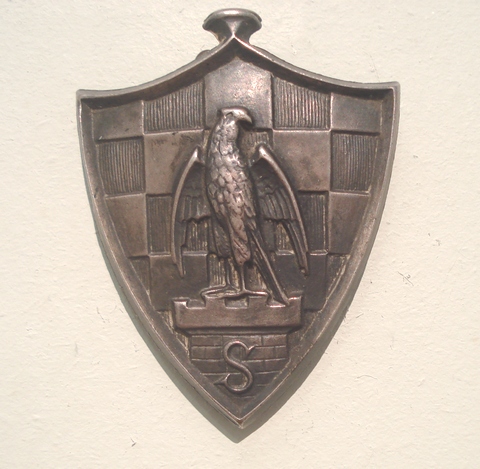
Ivo Kerdić: Medal of Hrvatski Sokol (Croatian Falcon), 1925
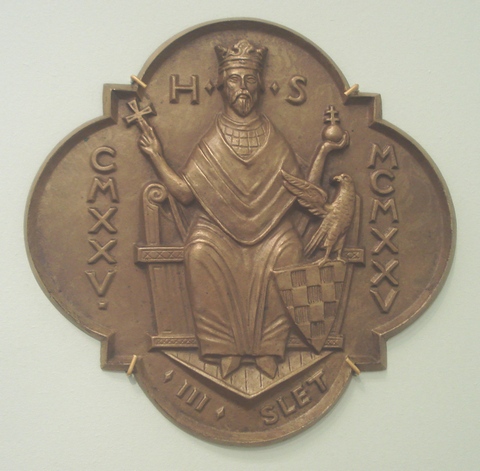
Ivo Kerdić: Medal for the Croatian Falcon, representing Croatian King Tomislav from 925 AD (on the occasion of 1000 years), 1925
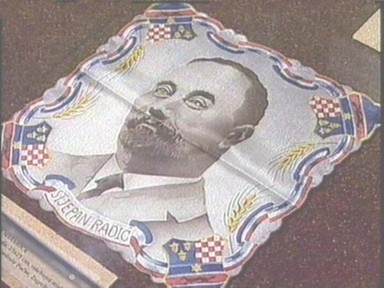
Stjepan Radic on a scarf from 1920s
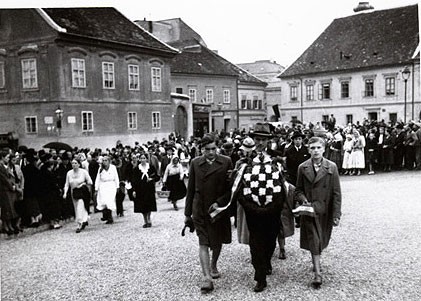
From the funeral of Stjepan Radic, 1928, Zagreb, assassinated in the Parliament of Yugoslavia in Belgrade
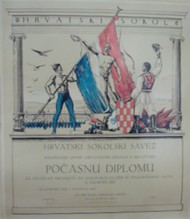
Diploma issued by the Croatian Falcon Federation to the Coratian Falcon Society in Bjelovar, Zagreb 1925
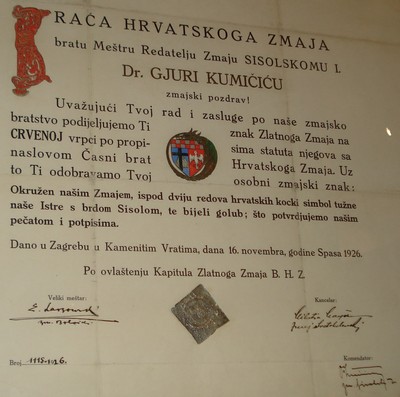
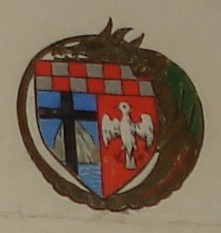
Coat of Arms of Dr. Gjuro Kumicic, 1926, by the rescript of the Brothers of Croatian Dragon.
Left below in the flag is the mountain of Sisol in Istria, in South-West of Croatia.
Kept in the City Museum of Zagreb
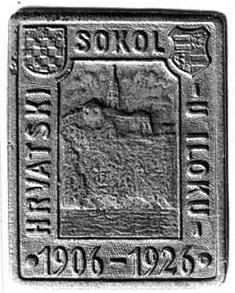
Badge of Hrvatski sokol in Ilok (Croatian Falcon in Ilok, sports society), 1906-1926, disappeared from the Museum of the town of Ilok during the Serbian 1991-1997 occupation of this Croatian town on Danube river. Source: Museum of the town of Ilok.
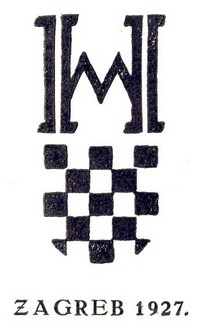
Logo of Matica hrvatska (Matrix Croatica) in 1927
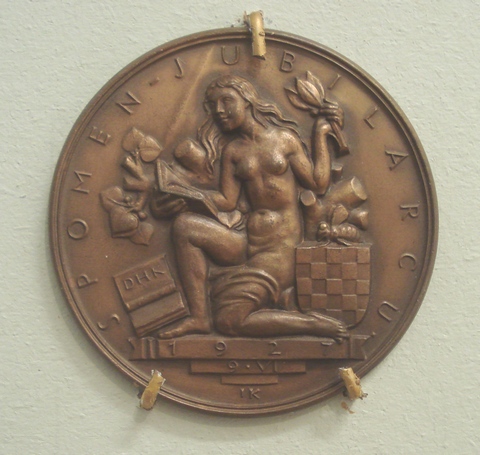
Ivo Kerdić: Medal of Ksaver Šandor Đalski, Croatian writer, 1927
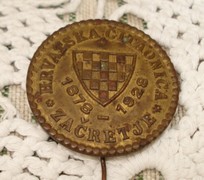
A badge of Croatian Reading Room in Začretje (Sveti Križ near Zagreb), 1878-1928
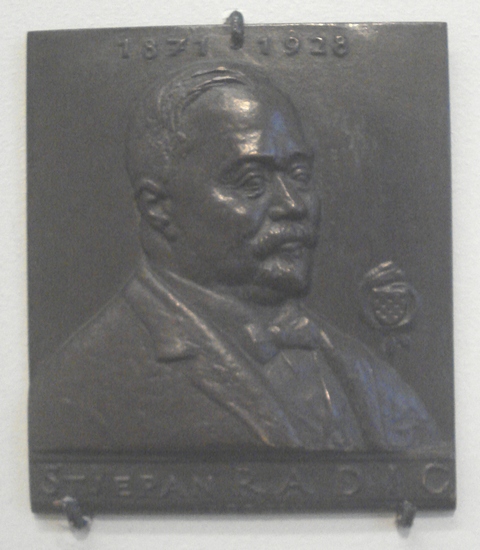
Ivo Kerdić: Medal of Croatian politician Stjepan Radić, made on the occasion of his assassination
in the Yugoslav parliament in Belgrade in 1928.
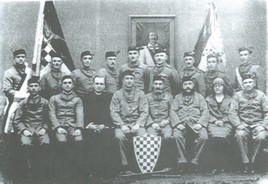
Hrvatski sokol (Croatian Falcon Sports Society), city of Karlovac, 1929
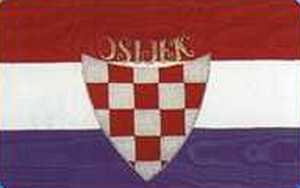
Hrvatski sokol (Croatian Falcon) Osijek, 1929, source
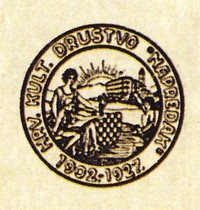
Hrvatsko kulturno društvo "Napredak" 1902.-1927.
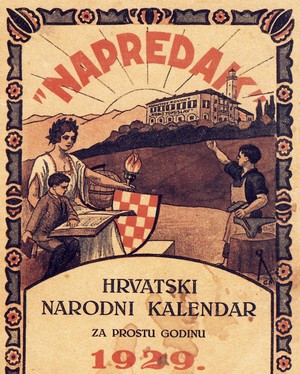
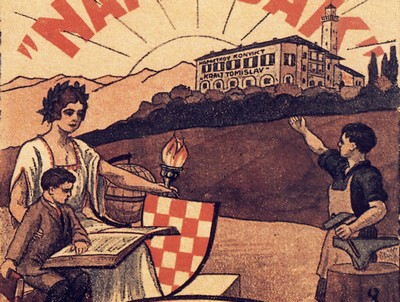
Napredak, Hrvatski narodni kalendar za 1929., Sarajevo (a detail from the cover page),
source [Maric, Pregled...]
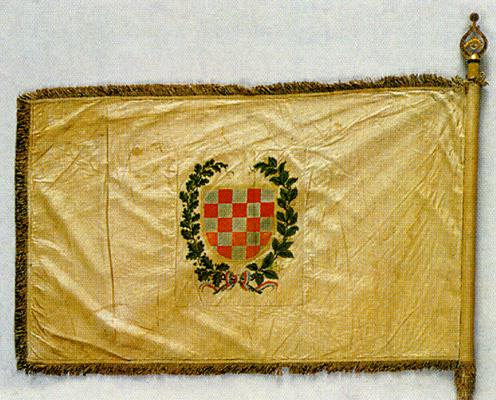
Flag of the Brethren of the Croatian Dragon (Družba braće hrvatskog zmaja), Zagreb, 1930
Croatian History Museum
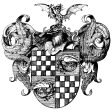
Coat of Amrs of the Brethren of the Croatian Dragon (Družba braće hrvatskog zmaja)
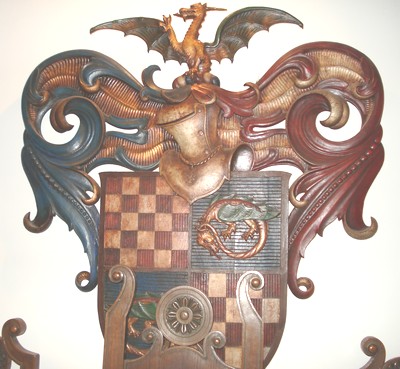
Amblem of the Druzba hrvatskog zmaja (Brethern of Croatian Dragon) in their building in Zagreb (Kamenita vrata), founded in 1905
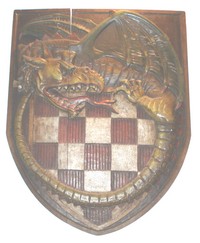
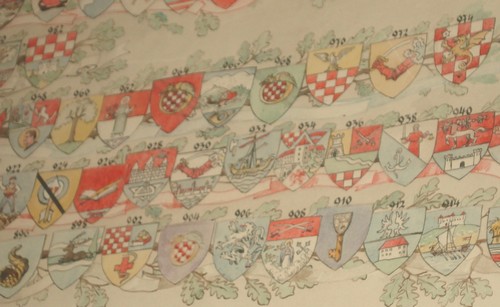
A detail from the tree of Croatian Nobility within Družba hrvatskog zmaja (Brethern of Croatian Dragon)
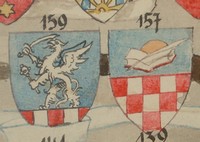
1910
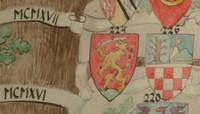
1916
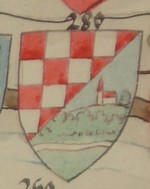
1919
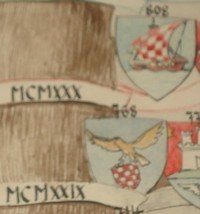
1929
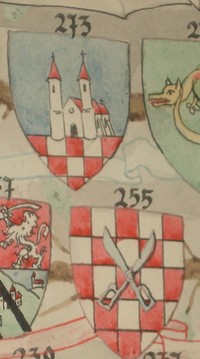
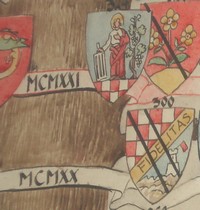
1920


1928
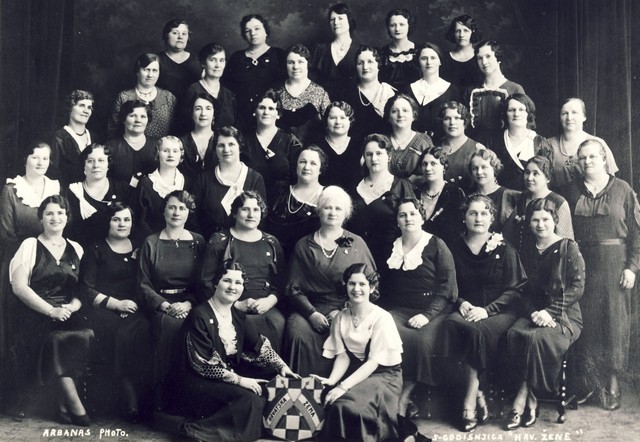
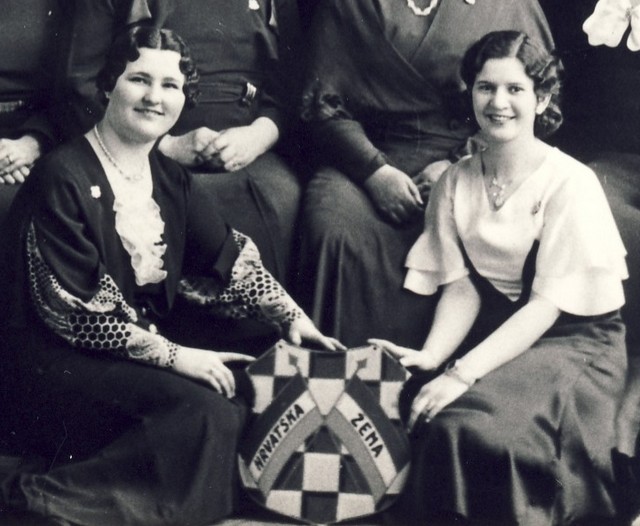
Hrvatska Žena (Croatian Woman) society, Branch 1 of Chicago founded on January 27, 1929. Another 18 branches were founded throughout the United States supporting churches, schools, charities and cultural programs as well as the American military during World War II. Source Vladimir Novak.
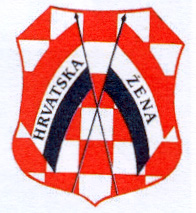
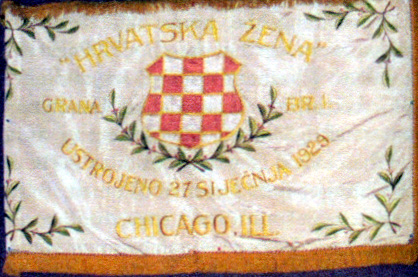
Hrvatska žena, ustrojena 27. siječnja 1929, Chicago ILL.
Croatian Woman, founded on January 27, 1929, Chicago ILL., source www.cuvalo.net
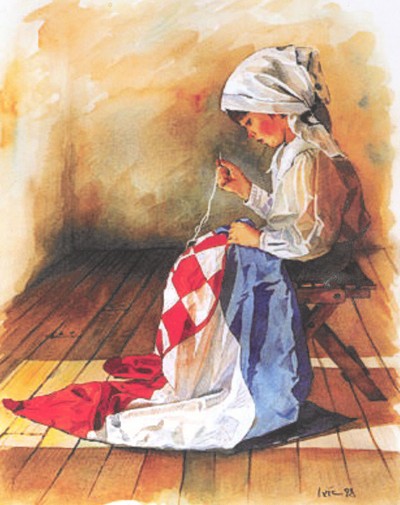
Hrvatska žena, grana br. 1, Chicago, 1929-2009
Croatian Woman, branch #1, Chicago, 80th Anniversary, source www.cuvalo.net
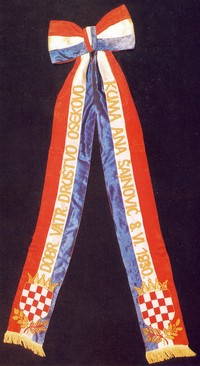
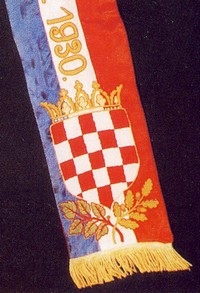
Croatian Coat of Arms on a flag of the fire station in the village of Osekovo in 1930, in the region of Moslavina, west of Zagreb; source Mandica Svirac (ed.): Lepa ti je Moslavina, Krscanska sadasnjost, Zagreb 1998., ISBN 978-953-151-209-4

Crkva Majke Božje Sljemenske - Kraljice Hrvata, Zagreb 1932, ceiling (detail)
The church is not far from the top of the mountain of Medvednica near Zagreb.
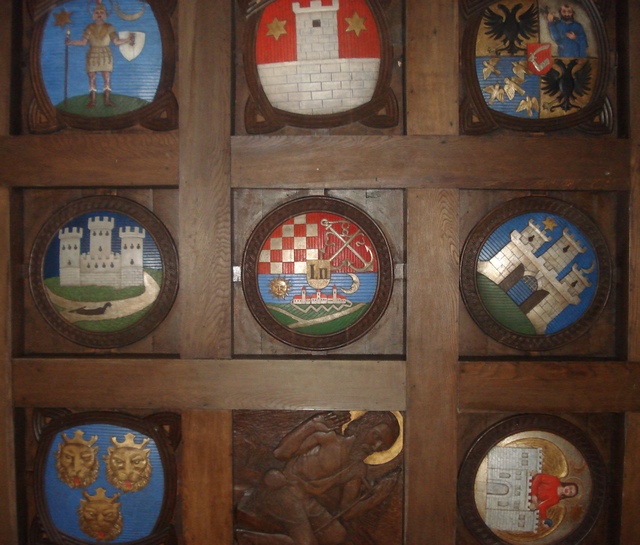
Detail from the ceiling of the church of Majka Božja Sljemenska - Kraljice Hrvata, Zagreb, 1932.
Architect Juraj Denzler, with participation of Croatian artists: Radoje Hudoklin, Vanja Radauš, Josip Turkalj, Marta Plazzeriano, Gabrijel Stupica etc.
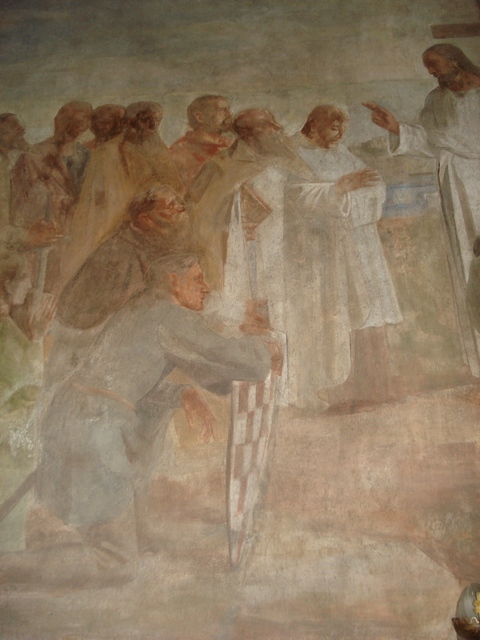
Majka Božja Sljemenska - Kraljica Hrvata, Zagreb 1932, a detail from the wall
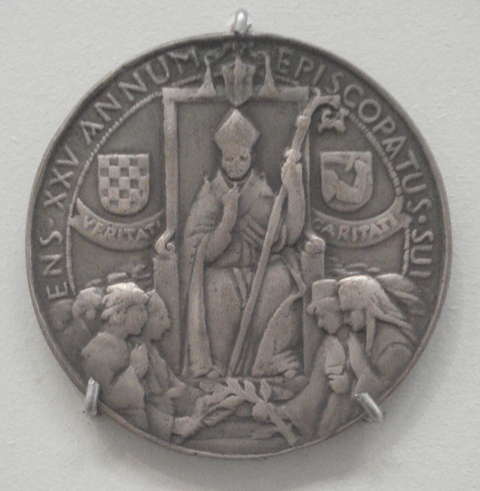
Ivo Kerdić: Medal of Ivan Šarić, Archbishop of Sarajevo, 1932
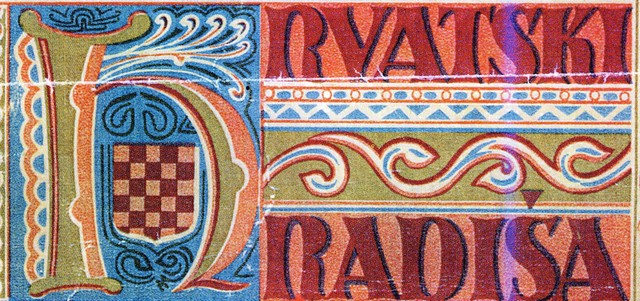
Hrvatski radisa, Zlatne ruke Krizevaca, published in 1934 (from the title page)
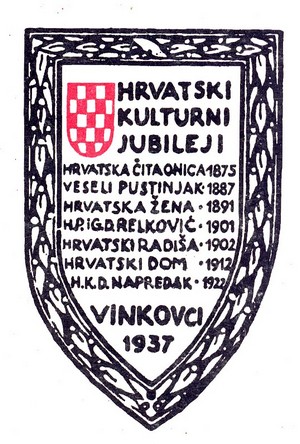
Croatian Cultural Jubilees in the town of Vinkovci, 1937
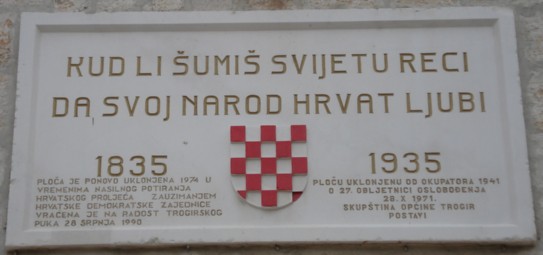
Croatian coat of arms on the City Hall of the town of Trogir with two verses of Croatian Anthem,
placed in 1935, removed by fascists in 1941, placed again thirty years later in 1971,
removed in 1974, and placed again in 1990!
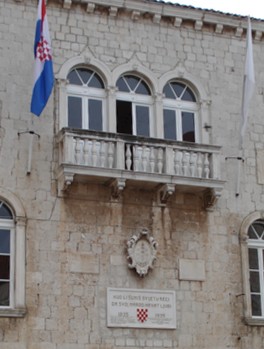
Trogir is one of the most beautiful Croatian cities, and under protection of UNESCO.
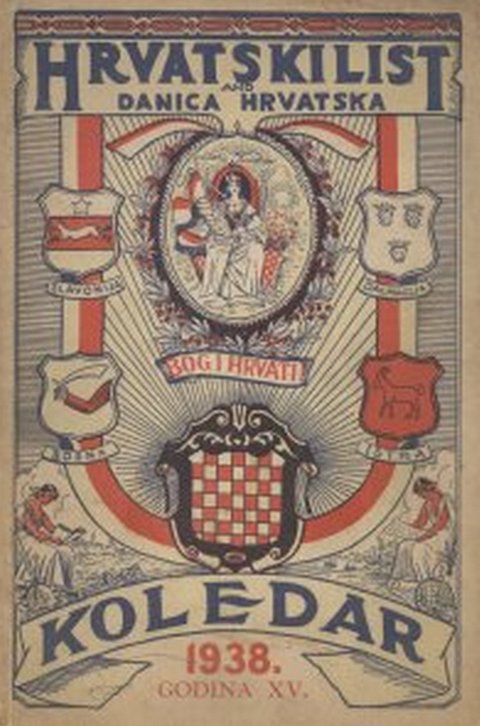
Croatian Newspaper and Croatian Venus, 1938
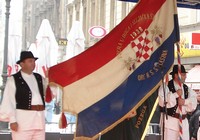
Croatian Peasant Society, a flag from 1938
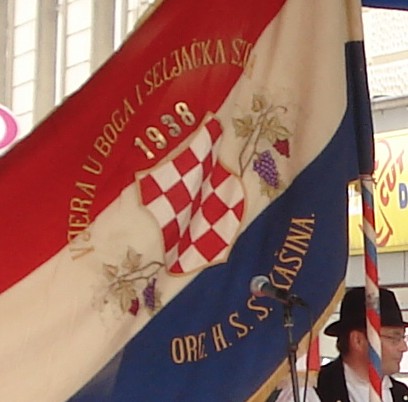
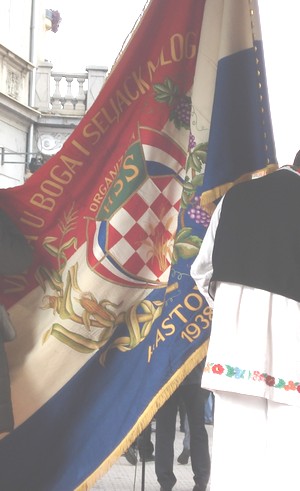
Croatian Peasant Society, a flag from 1938
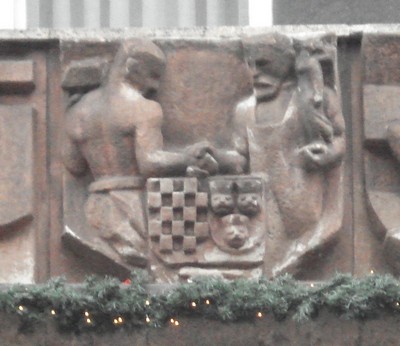
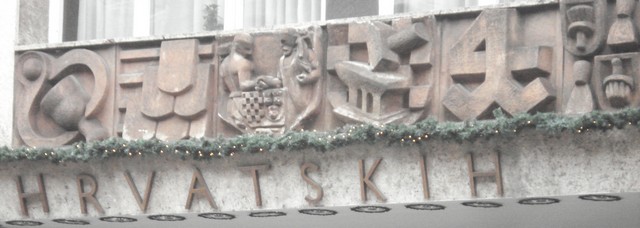
A detail from the building of Matica hrvatskih obrtnika (Matrix of Croatian Craftsmen),
Zagreb, Ilica 49 (between Frankopanska street and Britanski trg), built in 1938.
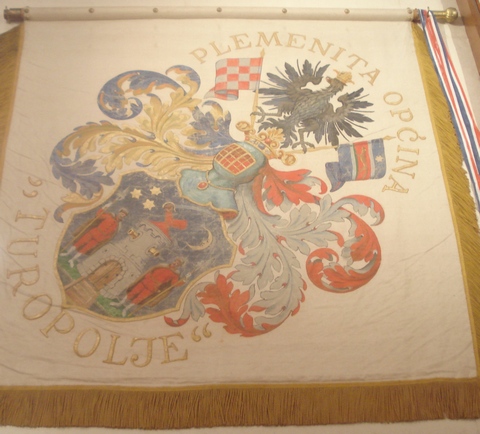
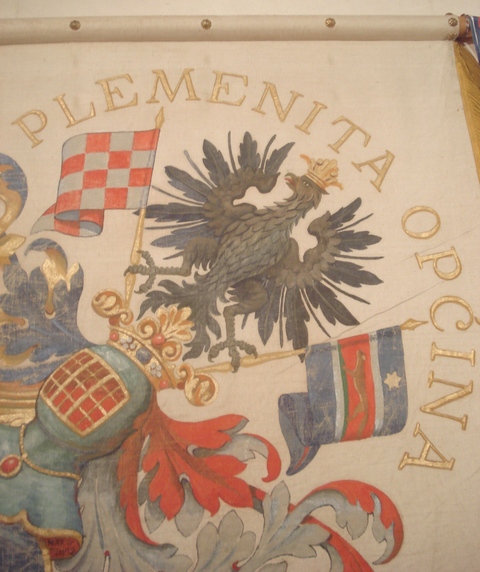
Coat of arms of the Plemenita turopoljska općina - Noble district of Turopolje from 1938
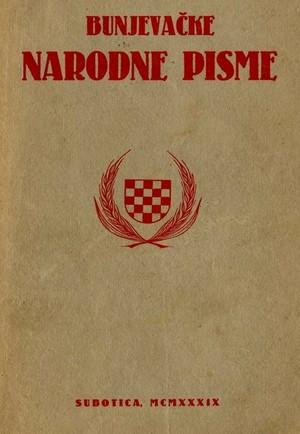
Ive Prčić: Bunjevačke narodne pisme (Bunjevac folk poems), Subotica, 1939.
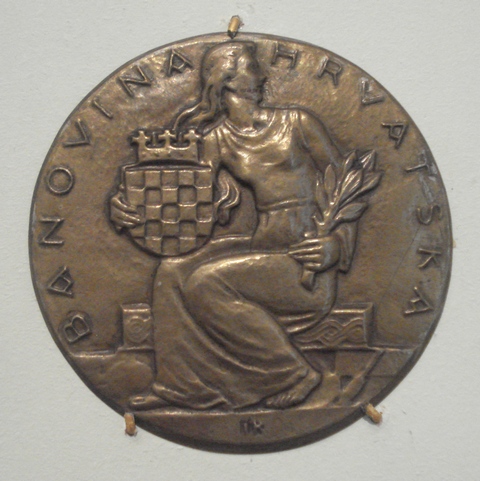
Ivo Kerdić: Medal of Banovina Hrvatska (Croatian Banovina), 1940.
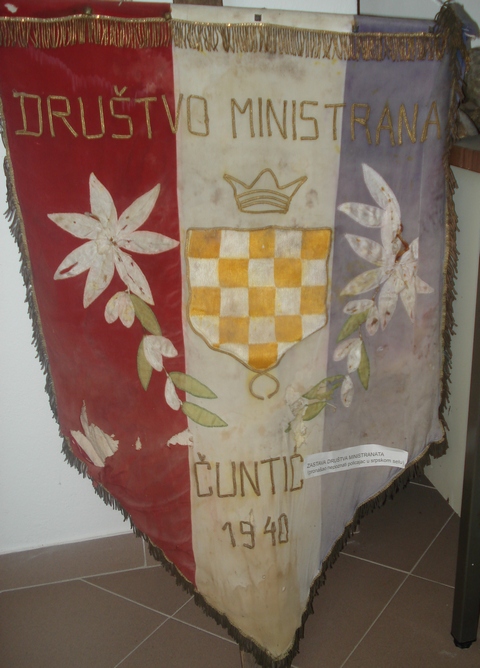
Grb ministranata 1940, village of Čuntić, Banija, Croatia
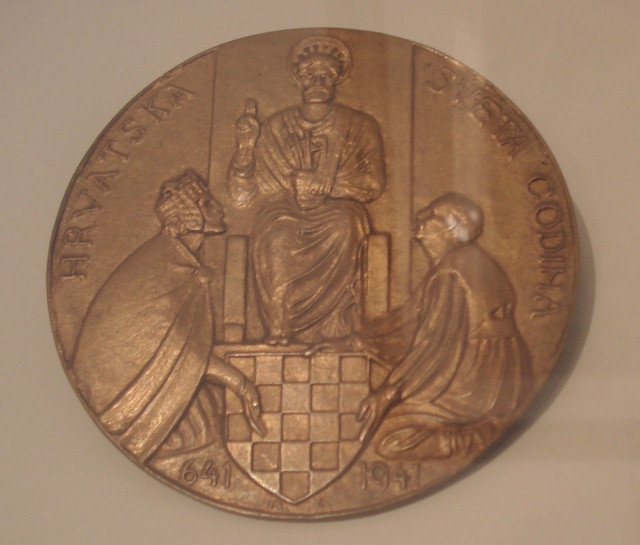
Mila Wood (1888-1968): 641-1941, Hrvatska sveta godina - Croatian Sacred Year (medal)
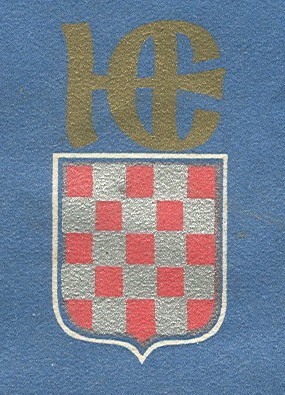
Croatian Encyclopaedia, 1938-1945
with ligature HE (Hrvatska Enciklopedija)
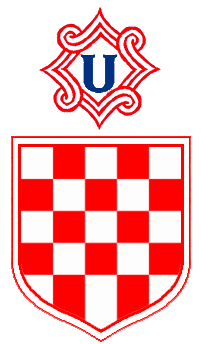
Coat of arms of the Independent State of Croatia (1941-1945)
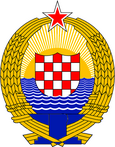
Coat of arms of the Socialist Republic of Croatia during the ex-Yugoslav communist period
Autograph of Kristian Krekovic, pintor croata-peruano,
with Croatian and Peruvian coats of arms
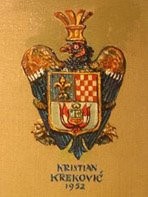
Coat of Arms of Kristian Krekovic, composed of centuries old Coats of Arms of Bosnia (lily) and Croatia.
Peruvian Coat of Arms is under them. Painted in 1952 during his sojourn in Peru.

Kristian Kreković's autoportrait from 1950, made in Cuzco in Peru, the old capital of Inca Empire.
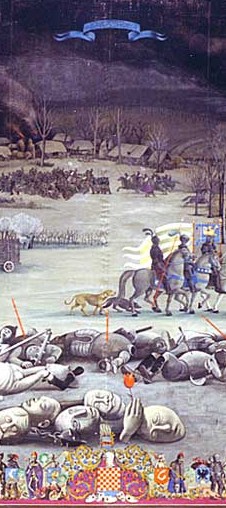
A detail from a ceremonial curtain of the Croatian National Theatre, Zagreb, by Krsto Hegedusic, 1969
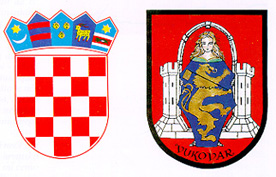
Coat of arms of the Republic of Croatia (1991) and of the town of Vukovar
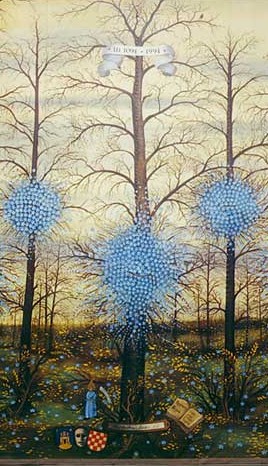
A detail from a ceremonial curtain of the Croatian National Theatre, Zagreb, by Ivan Rabuzin
One of our best theoretical physicists was Gaja Alaga (1924-1988), member of the Croatian Nobility from Backa and Bunjevci Croat.
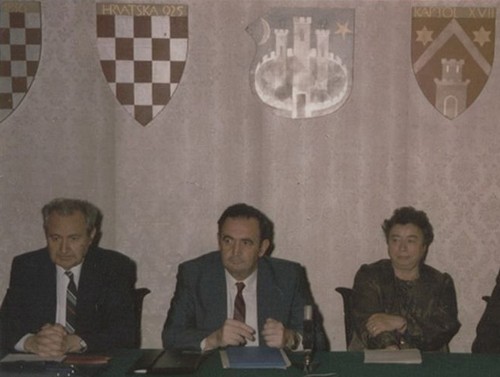
Professor Gaja Alaga on the left, a member of Croatian Nobility. Source www.knjiznica.phy.hr
He worked not only in Zagreb, but also at the Niels Bohr Institute in Copenhagen, Berkeley, Ludwig-Maximilians University in Munich etc. In 1955, in cooperation with K. Alder from Switzerland, A. Bohr from Denmark and B. Mottelson from the USA, he discovered the so called K-selection rules and intensity rules for beta and gamma transitions in deformed nuclei.
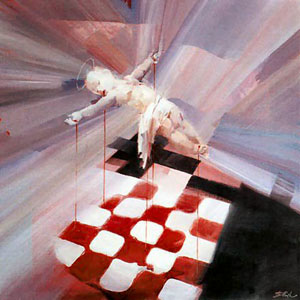
Christmas 1991
Charles Billich, see source

Zid boli (Wall of Pain) in Zagreb
From the Memorial room dedicated to Croatian defenders of the city of Dubrovnik (the room is in the very centre of Dubrovnik, within the Sponza palace):
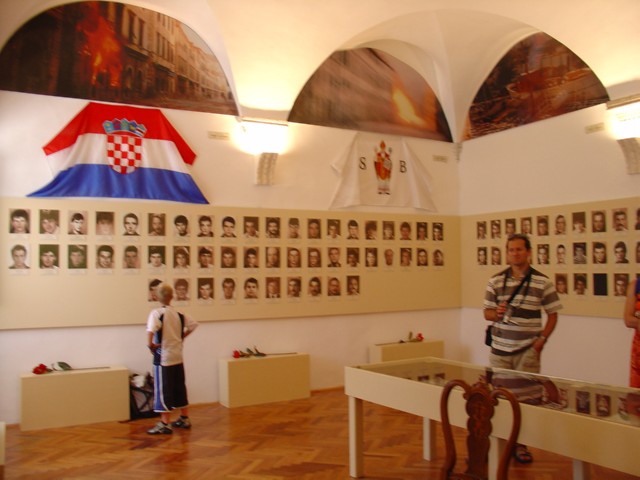
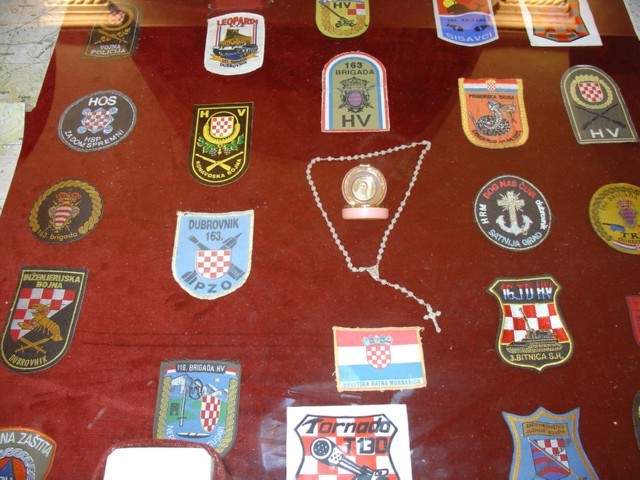
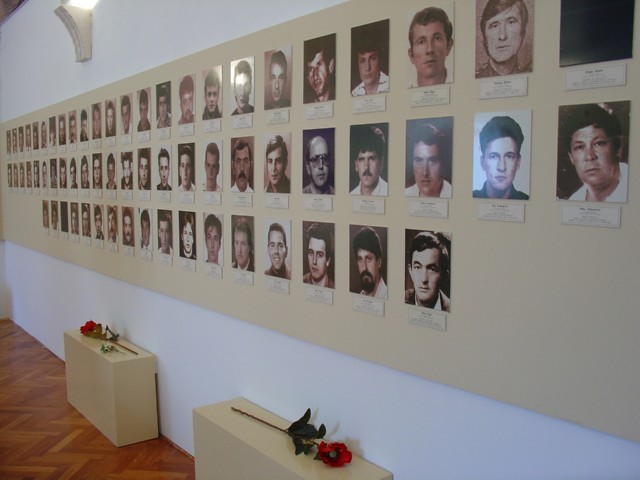

Goran Ivanisevic, with Croatian Coat of Arms, early 1990s,
during the most brutal Greater-Serbian attacks on Croatia
Storm Operation, 4-8 August 1995
liberation of parts of Croatia,
in particular of Lika and Knin, from Greater-Serbian occupation
ensuring safe connection between Zagreb, Zadar, Sibenik, Split, Dubrovnik,...
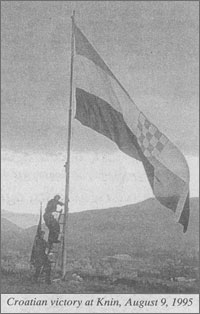
liberation of Knin,
Croatian town which never in history was a part of the so called Krajina
deblocade of the town of Bihac in BiH,
preventing the tragedy greater than that of Srebrenica in 1995
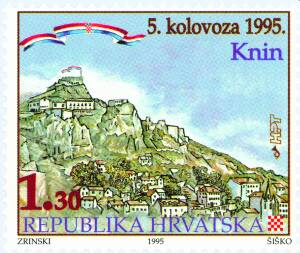
A stamp issued on the occasion of liberation of the Croatian town of Knin
during the Storm operation in 1995.
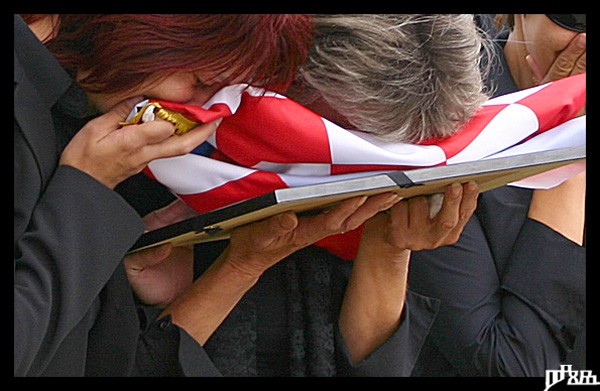
From the 2005 burial of Croatian defenders of the city of Vukovar, killed in 1991.
The women in the middle burried the two arms of her husband.
(copyright by Julija Vojkovic)
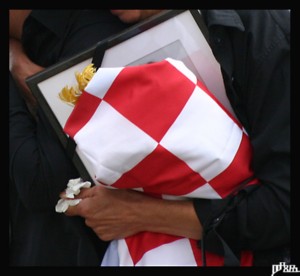
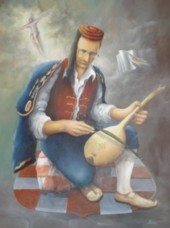
Don Petar Vuletic, Catholic priest, painter and poet, worked among Croats in Los Angeles (died in 1998).
This portrait made by Srecko Kriste is kept in Ravno, in Eastern Herzegovina, not far from Dubrovnik.
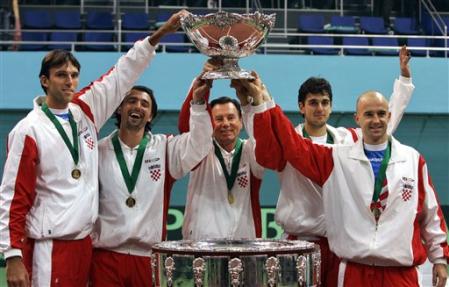
Croatian team won the 2005 Davis Cup Tournament in the final match with Slovakia in Bratislava.
This is one of the greatest achievements in the history of Croatian sport.
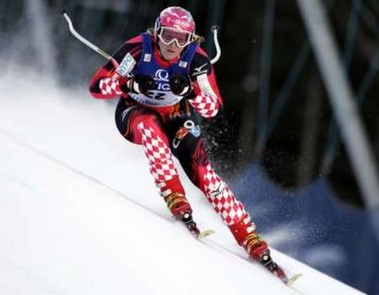
Janica Kostelic,
winning the 2006 Women Alpine Ski World Cup super-G race in Bad Kleinkircheheim
(photo by Ruters/Calle Teornstroem)
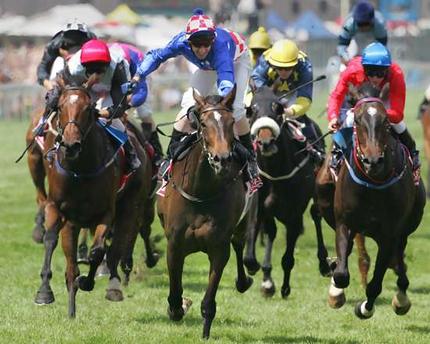
Glen Boss with Croatian Coat of Arms, riding on the famous mare Makybe Diva, owned by Tony Santic, Australia
Photo by Wayne Taylor

David Diehl, New York Giants, 2008, photo from CROWN
| 
Ivan Šarić, world chess champion for 2008 under the age of 18,
with Croatian Coat of Arms
|
Kimono Croatia worn in honour of Croatian ambassador Stambuk's birthday
Tokamachi factor, a paradigm for Japan-Croatia emotional attachement
The winning silk kimono named Croatia has been made in Tokamachi in the memory of the Croatian national football team's presence during the World Cup 2002 in Japan. The Mayor's daughter has worn it for the Croatian ambassador's birthday.
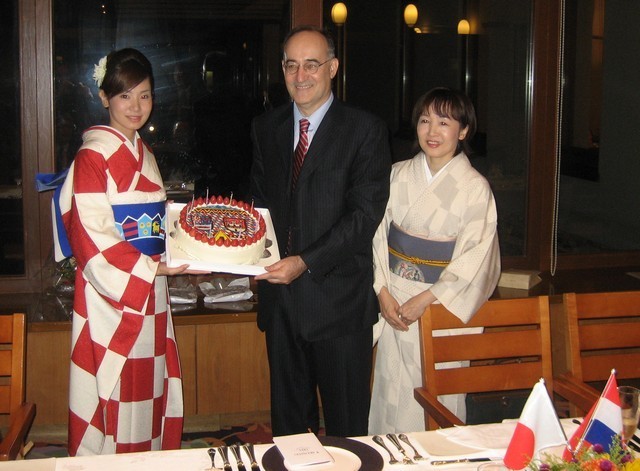
For more details see Kimono Croatia
Photo by the courtesy of Dr. Drago Štambuk, ambassador of the Republic of Croatia in Japan.
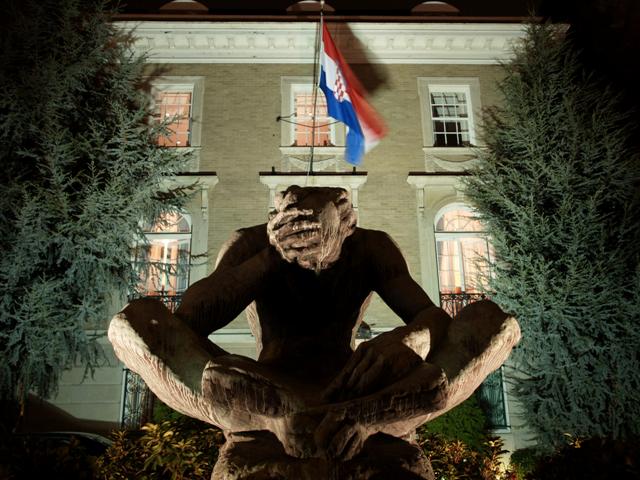
Ivan Mestrovic's St. Jerome in front of the Croatian Embassy, Washington DC, USA
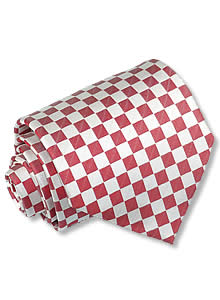
Cravate, photo from www.croata.hr

Grb Primorsko-Goranske županije
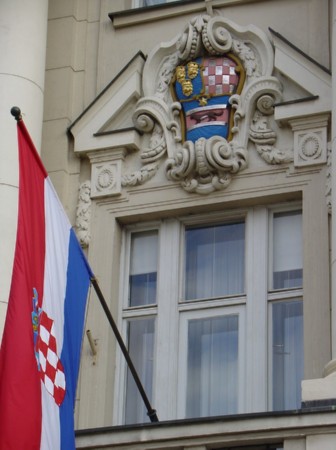
Croatian Parliament - Hrvatski Sabor, Zagreb
with an old Croatian coat of arms
References
- Grakalić, Marijan: Hrvatski Grb, Nakladni zavod Matice hrvatske, Zagreb, 1990.
- Stan Granic: Evolution and use of the Croatian coat of arms, The Canadian Slavonic Papers, Sep-Dec 1996
- Adam S. Eterovich:
- Croatian and Dalmatian Coats of Arms, Polo Alto, California, 1978 [illustrated collection of over 3000 family coats of arms]
- Croatian Coat of Arms
- A Guide and Index to Croatian Coats of Arms, Ragusan Press, San Carlos, CA, 2003
- Goroslav Ostric: Grbovi u gradu Bakru, Pomorski i povijesni muyej hrvatskog primorja, Rijeka 1996, ISBN 953-96915-0-8
- Jean-Pierre Claus: Hrvatsko Grbovlje u Belgiji (translated from French, Belgium), Zariste, Naklada Ceres d.d., Gornja Jelenska, 2007. , 87 pp., ISBN 953-267-002-5 [Jean Pierre Claus dugi je niz godina istraživao hrvatske tragove u Belgiji. Tako je uocio i impresivne hrvatske grbove razasute po cijeloj Belgiji: po vitrajima belgijskih katedrala i crkava, u raznim ilumiranim knjigama i dokumentima iz razdoblja habsburške monarhije. Autor je svoja istrazivanja iznio u ovoj zanimljivoj knjizi u kojoj je ispricao cijelu povijesnu pozadinu hrvatskih grbova u Belgiji. Ima ih cetrdesetak i vecinom su izuzetne ljepote tako da ih u heraldici smatraju pravim remek djelima, a u Hrvatskoj se o tome gotovo ništa ne zna. To je doista knjiga koja nam otkriva jedan dio naše ljepše povijesti, a to nam takoder dokazuje koliko je Hrvatska tada bila dijelom europske povijesti. Source.]
- C. Michael McAdamas: Croatia - Myth and Reality
- Aleksandar Benazić: Podrijetlo simbola kune na hrvatskom novcu
- Fojnica na Internetu -> grbovi
- Janko Ehrlich Zdvorák: Croatian Symbols
- Ruzica Kovačić Kolarević: Zbornik hrvatskoga plemstva, Golden Marketing, Zagreb 2006.
- Ivan Bojničić: Der Adel von Kroatien und Slavonien, reprinted by Golden Marketing, Zagreb 1995.
- Enver Ljubović: Grbovi i plemstva Gacke i Like, Adamic, Rijeka, 2001
- Dr. Franz-Henz Hye (Stadtarchivdirektor): Das Staatswappen von Kroatien und seine Afänge in Innsbruck, Innsbrucker Stadtnachrichten, März 1992, p. 23
- Jelena Borošak-Marijanović: Zastave kroz stoljeća, Hrvatski povijesni muzej, Zagreb 1996., ISBN 953-6046-075-5
- Maja Škiljan (ur.): Museum 1848.-1996., Hrvatski povijesn muzej, Zagreb 1996., ISBN 953-6046-09-1
- Jasna Tomičić: Stjepan Radić, Hrvatski povijesni muzej, Zagreb 1991.
- Ankica Pandžić (ur.): Stoljece promjena, Hrvatski povijesni muzej, Zagreb 2001, ISBN 953-6046-21-0
- Ankica Pandžić (i dr., ur.): Kolomanov put, Hrvatski povijesni muzej, Zagreb 2003., ISBN 953-6046-26-1 (in particular pp. 35, 113, 119, 227, 230, 231, 233, 240)
- Vlasta Brajković: Grbovi, grbovnice, rodoslovlja, Katalog zbirke, Hrvatski povijesni muzej, Zagreb 1995., ISBN 953-6046-05-9
- Ratkaji Velikotaborski, Drustvo Veliki Tabor (predsj. Josip Stimac), Desinic 1993.
- Branka Molnar: Arma, Grbovi iy fundusa Drzavnog arhiva u Zagrebu, Zagreb 2003.
- Miroslav Prusac: Razglednice s hrvatskim nacionalnim motivima
- D. Novak, M. Lapaine, D. Mlinarić: Five Centuries of Maps of Croatia (Pet stoljeca geografskih i pomorskih karata Hrvatske), in English and Croatian, Školska knjiga, Zagreb 2005, ISBN 953-0-61571-X
- Suzana Leček: Moj Zagreb, Laurana : Duplo P : Libar, Zagreb 1998., ISBN 953-97659-0-0
- Mario Jareb: Hrvatski nacionalni simboli, Alfa, Hrvatski institut za povijest, 2010.
- Tatijana Gareljić: Ivo Kerdić, Moderna Galerija, Zagreb, 2011 (exhibition catalogue, in Croatian and English) ISBN 978-953-7662-45-5
- Dubravka Peić Čaldarović, Nikša Stančić: Povijest hrvatskoga grba, Školska knjiga, Zagreb 2011.
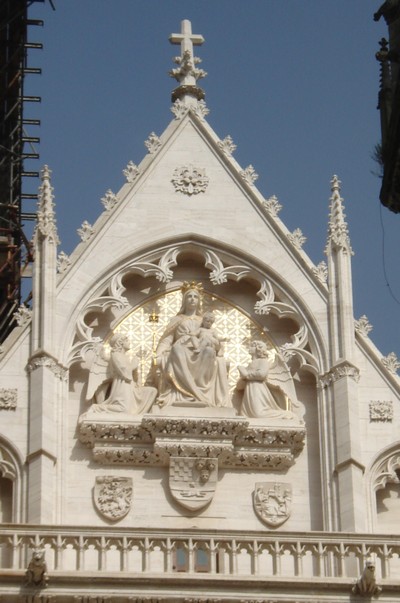
The Zagreb Cathedral, a detail from the front side, photo from 2008.
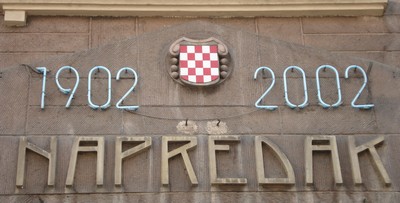
A detail from the building of Napredak, Sarajevo, BiH,
Croatian cultural society, photo from 2008.
This web page has almost an impossible task: to answer an insinuation of the BBC (The British Broadcasting Corporation) about the alleged Nazi origin of the Croatian coat of arms. Precisely, in the biography of late Croatian president Franjo Tudjman, offered by the BBC in an unsigned article, it is stated that "...His brand of nationalism included restoring the flags and other symbols used by the old fascist Ustasha regime that had fought alongside the Nazis during World War II." This misrepresentation has done (and is still doing) enormous international damage to Croatia. I have noticed it in 2005, but it exists as such since 1999. It was the only reason why I undertook preparing this web page.
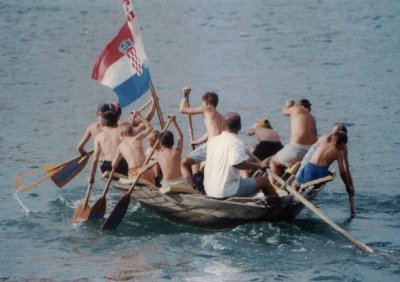
5th Maraton Lada, 2002, Croatian Sports
Formated for CROWN by Darko Žubrinić
Distributed by www.Croatia.org . This message is intended for Croatian Associations/Institutions and their Friends in Croatia and in the World. The opinions/articles expressed on this list do not reflect personal opinions of the moderator. If the reader of this message is not the intended recipient, please delete or destroy all copies of this communication and please, let us know!